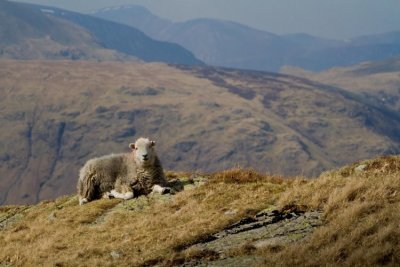Environmental change in Scotland's uplands
The Scottish uplands are generally defined as the land above the level of agricultural enclosure, which is typically 300-400m above sea level (ASL) but often lower, especially in the far north. The uplands may be divided into the montane and sub-montane zones, the former beginning at the theoretical tree-line (up to 600-700m ASL, and descending as one moves north). Natural tree-lines are rare in Scotland, but can still be seen, for example at around 640m ASL on Creag Fhialcach in the north-east.
Whilst renowned and revered for their wildness, Scotland’s uplands have borne the footprints of human activity for millennia. Low-intensity arable and livestock agriculture, arguably coupled with natural herbivore grazing, created an open landscape with very little woodland cover by 1700 AD.
The next century saw the introduction of hardy sheep breeds able to withstand year-round exposure to upland weather conditions, and a subsequent step-increase in grazing intensity. In the nineteenth century, highland sporting pursuits gained popular favour, further influencing the landscape by promoting high densities of deer and grouse for shooting.
A major change followed the First World War, when subsidies were made available to encourage planting of commercial conifer forests in the uplands, and livestock grazing was favoured by payments for extensive drainage after the second war. Intensification of grazing reached a peak in the last decades of the twentieth century when European funding, via the Common Agricultural Policy (CAP), solely rewarded production as the key agricultural output.
In the twenty-first century, subsidies have begun to favour wider aspects of land management, such as water quality, biodiversity and carbon storage, whilst management for game shooting is arguably declining. Grazing pressures are decreasing, heather is being replaced by rough grass and conifers, and renewable energy has become a key economic activity in the upland environment. Upland land use is currently dominated by the three principal activities of livestock farming, commercial forestry and fieldsports (grouse shooting and deer stalking).
This long history of human activity means that only the high altitude montane zone can be considered natural or near-natural, and in this respect is the most extensive habitat of its kind in the British Isles. Montane vegetation comprises a diverse assemblage of bryophytes (liverworts and mosses), lichens and prostrate (low-growing) vascular plants, whilst the sub-montane region is characterised by heather, acid grassland and, increasingly, commercial conifer plantations.
The future of upland habitats, and of the species that depend on these habitats, is uncertain due to changes in both climate and land uses. Pressures from grazing, sporting management, forestry, erosion, drainage, wind energy and hydroelectric schemes will interact with changes in climate (including temperature and rainfall). These complex realtionships are also interlinked with socio-economic factors.
At present, changes in the size of upland bird populations are not as well monitored as those for other major UK habitats, due to relatively low numbers of human observers in these areas. However, various single-species surveys have revealed declines in certain upland species including black grouse, ring ouzel, wheatear, twite, curlew and dunlin.







Share this page